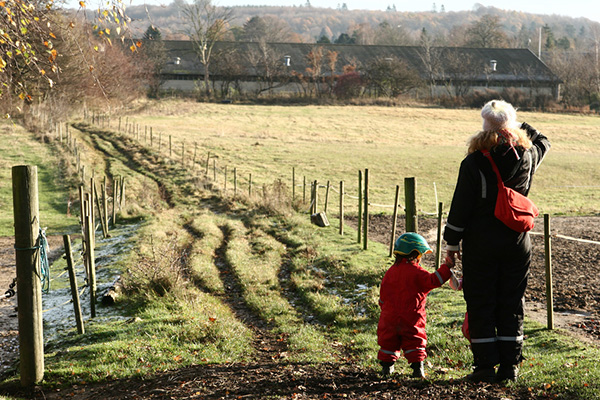Designing for kids is a unique and challenging situation for any UX professional. While many principles and practices span across all ages, there are many issues which arise exclusively when dealing with children. In this introductory article we’ll look at kids and the specific issues that they bring about. We’ll also examine some guidelines, constraints, and considerations that you should take into account when designing UX for kids.
Kids These Days
So, what do I mean when I say “kids”? In order to keep this article as broad as possible I’ll use kids as an all-encompassing term ranging from any child as young as toddlers up to young teenagers. I know there’s an enormous chasm among that range but I’ll try to keep my points as general as possible and call out specifics as needed.
Generations
Let’s look back a bit at the separation of generations. Keep in mind that those listed are largely U.S.-specific; while the general principle of generations may still apply internationally, the specifics between generations and when the separations occur will likely differ.

Cultural, technological, scientific, and industrial changes often lead to the differences in generations. These differences across many different facets of life affect how people react and behave toward technology. We have to be able to take those into account when designing UX. Here are the last four generations:
- Baby Boomers 1946 – 1964
- Generation X 1965 – 1976
- Millenials 1977 – 1996
- Pluralists 1997 – Present
I call out the Pluralists because these are the kids of today. They are called the Pluralists because they are the most diverse generation to date. They are diverse in many factors including ethnicity, family make-up and religion. These factors affect the technology kids interact with and their thoughts on it.
I still list the other generations because they make up the majority of those designing the UX. Although, in the next few years we’ll start to see Pluralists move into the UX field and start designing for their own generation.
Much more can be said about the actual differences in generations and how they affect kids, but for the purposes of this article I’ll leave it at the fact that generational change is significant when it comes to designing UX for kids. Dive into the make-up of the generation, what they care about, and why.
Key Considerations
Let’s nail down some of the things we should be taking into account here.
Big Differences in Small Ages
I’ve seen over and over again that differences as small as a year can make a huge difference in kids. They are still developing and at a pretty rapid pace. The difference in two children a year apart is often larger at younger ages, but can also be affected by other life events and changes.
For example, think about the difference going from elementary school to middle school. It’s an almost immediate change in what kids like, don’t like, and the level they are willing to go to in order to try to fit in with other kids. A television show that they may have loved just months ago is suddenly too “baby-ish” for them. A toy that, last year, they played with daily for hours on end is swiftly thrown to the back of the closet.
Motor Skills
Motor skills may not be fully developed in children, especially at younger ages. This affects their use of mice, trackpads, and touch devices. Small targets and UI nuances may be tough for kids to interact with. Accordingly, the application of Fitts’ Law may need to be exaggerated with children. Since their movements may not be as precise, provide them with larger targets.
Memory and Cognition
A child’s brain is still developing, so their capacity for memory is also going to be lower. There are a couple of things in interfaces we can do to combat this.
Chunking. The rule of thumb is that people can typically remember 7± bits of information. This is partly why American phone numbers are broken up into the format 123-456-7890. Breaking them up into three chunks of three or four numbers is easier to remember than a long string of ten numbers. Even though they are technically the same, the chunking helps the brain to fool itself into thinking there’s less to remember at each point in time.
This works with pieces of information as well. If we chunk like bits of information into smaller groups then they will be less overwhelming. This principle applies to all interfaces, but is magnified with children.

World vs. Head. Don Norman talks about the idea of knowledge in the head vs. knowledge in the world in his book The Design of Everyday Things. Knowledge in the head is stuff that someone must remember, while knowledge in the world is presented to them so that they don’t have to always keep it in their head.
Help kids to find information that may be hard to keep in their head, and help them keep it in the “world.”
Dumb It Down?
It seems that a lot of people assume that it’s necessary to dumb down an interface for kids. That’s absolutely not true. I’ve seen time and time again that kids are way smarter than they are typically given credit for. They may have different tendencies, but can still navigate a fairly complex interface.
Make a product that kids will love, not a product that *only* kids will love.
Constraints
The Children’s Online Privacy Protection Act was enacted in 1998. It was ostensibly designed in order to protect kids and their privacy while online. That translates to restrictions on the types of data sites can collect about kids. There’s a lot to the Act so visit coppa.org for more information.
At its base though, C.O.P.P.A. restricts the collection of Personally Identifiable Information (PII). I want to talk about three specific things that the disallowance of PII collection restricts when designing UX for kids.
For clarification, C.O.P.P.A. applies only to sites that are targeted towards kids, not sites that may just have kids visit them.
Data
You have to be very careful with the data that you collect when your site is a kids-targeted site. C.O.P.P.A. severely limits the data that you can collect such as email addresses, IP addresses and anything that may describe the child or their whereabouts. It also requires that you purge unused data within a reasonable amount of time. Make sure you are complying with C.O.P.P.A. restrictions whenever setting up your data collection and analytics.
Social Media
Social media is huge, especially with teenagers. Most social media sites technically don’t allow children under 13 to create a profile. However, many children circumvent this either by using a parent’s account/information, or by plainly lying about their own information.
Still, if you are resposible for a kids’ website then you cannot hook into social media. Because they typically house PII, it would be tying information to your site that breaks C.O.P.P.A. law.
User-Generated Content
User-generated content usually has some sort of PII tied to it due to the nature of it coming from a user. Unbeknownst to many, even pictures from your iPhone carry a pretty rich set of metadata tied to them that alone would break C.O.P.P.A. law. User-generated content can be done for kids’ sites but you will have to jump through several hoops in order to do it while still complying with C.O.P.P.A.
The 5 Ps of Designing UX for Kids
Now, to the fun part. These five Ps are not comprehensive of all that you should take into account, but are a good starting set of considerations when you are designing UX for kids.
#1 Parenting
Most of the time we look at users as autonomous beings. Sure, there are outside influences, but we typically view the user as being the sole controller of their experience. Parents have a huge influence and sometimes direct control over their child’s experience. While our UX is focused on what the kid desires, we have to also take into account parents and their concerns.

Take, for instance, in-app purchases on mobile games. Accounts are typically tied to a parent’s credit card. With in-app purchases being a potentially large money drain, some parents have instilled a fear in kids to stay away from in-app purchases. This creates a challenge in creating that type of revenue stream in kids’ mobile games. This can be curbed by creating in-app purchases that are about content and are one-time purchases. That approach can help reassure parents that a child won’t continuously pour money into the same app.
Other instances may call for messaging directly to parents. Maybe it’s knowledge the child wouldn’t have, or a use case that may make the child nervous to proceed for fear of “getting in trouble” for whatever reason. Cases such as these can be aided by telling kids to get their parents involved and then messaging to the parents about what’s occurring. This helps alleviate fears in both parents and children.
#2 Play
The base definition of “play” is any activity engaged in to amuse oneself. Basically, the means to the end—which is fun. “Fun” is a fuzzy word that is subjective to each individual experiencing it. Therefore, there’s no standard way (at least that I’m aware of) to quantify fun.
That’s why I like Zimmerman and Salen‘s definiton of play:
Play is free movement within a more rigid structure.
Let’s take a look at video games as an example. The first game I ever played was Super Mario Bros. Its interaction was very simple, as a user was set on a predetermined course and only allowed to run sideways and jump (and maybe spit a fireball). That free movement within confined rules created play.
Today we see massive worlds like Grand Theft Auto 5 where a player is allowed to perform nearly an infinite number of things within an open world. This creates an immeasurable number of play scenarios. The free movement is expanded and therefore so are the ways in which a player can play.

This also works in an educational setting. During my childhood I got to experience such programs as “LOGO” and “Math Blaster” while in school. These took subjects that may otherwise have been boring and enveloped them in a wrapper of play. That small change of angle helped me and others to become fascinated with those subjects in a way that they wouldn’t have in a straightforward teaching setting.
Even in college I saw this play out when I took a difficult programming class. I did not understand the material very well and subsequently didn’t perform well in the class. After I had switched majors, I took the same class but this time it was taught from the perspective of programming Game Boy Advanced games. That little element of play revealed the material in a whole new light for me and I aced the class.
Play is crucial to a child’s development. I just outlined how play can be used in both entertainment and pedagogical settings. It helps hold kids’ attention and attracts them back for more. Utilizing play is one of the biggest factors that can make your product successful with kids. Don’t limit yourself to just using it in games though. Look for all sorts of little ways that play can be implemented into your UI and UX.
Here are some additional sources for more on play:
- Playful Design– John Ferrara
- Rules of Play– Eric Zimmerman and Katie Salen
- A Theory of Fun– Raph Koster
#3 Practice
Kids repeat things over and over. Think of the three-year-old who has just finished a movie for the tenth time in a weekend. There’s actually a very good reason kids do this. To illustrate the point, let’s look at the former television show Blue’s Clues. They would air an episode five days a week from Monday to Friday. However, each week they would air the same episode every day during that week. They did this because kids wanted to watch the same episode each day in order to master it. By Friday the kids had mastered the episode and could take great joy and achievement in being able to recite the episode and sing all the songs.
In UX, this plays out in the concepts of Familiarity and Repeatability. You want to use design patterns and methods that are very familiar. Kids are not typically an audience you want to get very experimental with. Kids want to know what they can expect and will use the habits and methods they’ve learned. They may not quite be able to make the same associations and assumptions that an adult might. Like most web users, if kids grow frustrated with your UX then they will choose another destination for whatever they desire.
When you watch a kid learn, you see there’s a recognizable pattern to what they do. They give it a try once — it seems that a kid can’t learn by being taught. They have to make mistakes themselves. They push at boundaries to test them and see how far they will bend.
This also means that you need to account for kids testing the boundaries. Pay careful attention to error messaging and fringe use cases. Kids will push at the edges and if your site doesn’t handle that gracefully then you may lose them as a user.
#4 Patience
Kids don’t have a lot of patience. They want to immediately find something that interests them. If they don’t, they will quickly move on to the next thing. Not only does this mean that your content must be good, but so must your technology. Fortunately, there are some UX tricks and practices to help curb your worries about losing kids’ attention.
Allow Play During Waiting
If you need to allow time for loading then find methods of play during that waiting. Perhaps you can serve up a card game or a simple game of pong. Maybe you can show them an interesting or funny video. You can even play with the loading screen and add elements such as ancillary animation to make it fun. Showing a simple loading bar that takes a while to load content is a good way to make a kid run to another destination.

Fake Progress
Sometimes, when a user interacts with a UI, you have to send information to a back end for processing. That can take time. Meanwhile, your user will want to know if you at least received their input. This is when you can fake progress on the front end while you send the information to the backend.
If an error returns then message the user, but with many actions you can assume that their action was successful and fake that success to the user. For more, see this article from Luke Wroblewski.
Think Mobile for Speed
Mobile First is an approach that helps prioritize content and reduce the amount of content you believe is necessary. This approach can help in another important aspect; speed. Because mobile devices often don’t have great connection speeds, a mobile first approach will try to optimize for speed using various techniques.
This approach can be used even if you are not creating a mobile or responsive site. If you use very similar techniques to try to optimize for speed then you can help speed up loading times and general performance of your site. This will help curb the impatience that kids can naturally have.
#5 Popularity
Displaying items by popularity is a technique used in many products. It’s even more important in kids’ products. Popularity is a sign of social status. At various stages in children’s lives they try different methods of fitting in with others. Attaching themselves to what’s popular is one way they do so. If you can float up items by popularity then kids may gravitate to that content in a way they wouldn’t without that popularity framing.
What’s Next?
That wraps up my introduction to the world of UX for kids. In the next article we’ll discuss what to do once the UX is handed off, as well as some intangibles a great kids UX Designer possesses.
